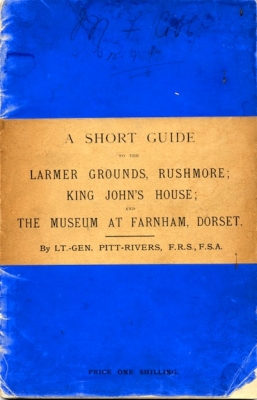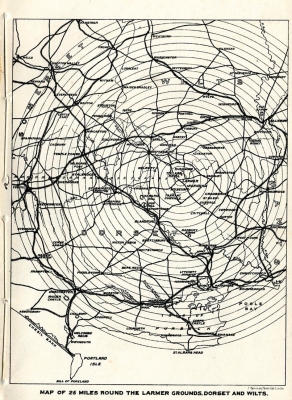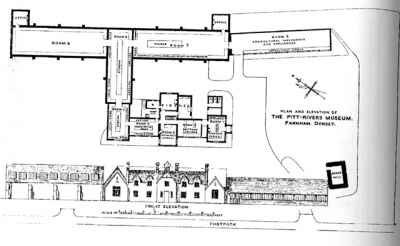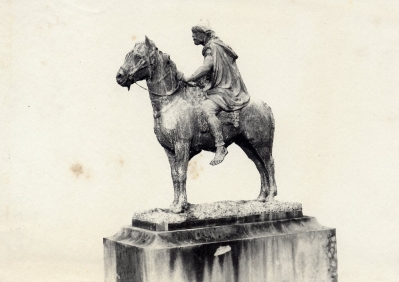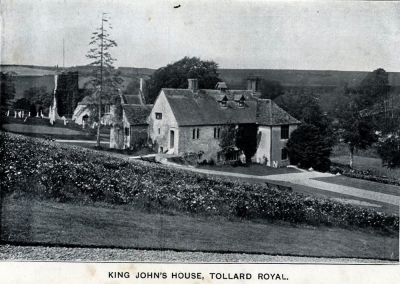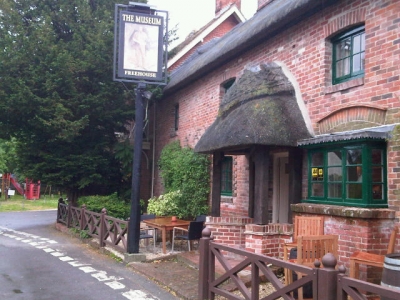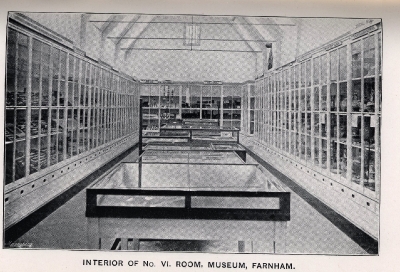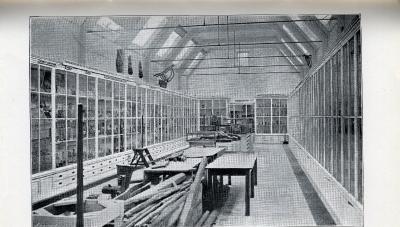To search the RPR site click here
Larmer, Farnham and King John's House Guide, 1894
There were at least two editions of the guide to the Larmer Grounds, Farnham Museum etc, written by Pitt-Rivers, this transcription is taken, it seems, from the earlier edition published in 1894. Here is the other version.
Going to the Larmer Gardens or to the Museum or King John's House was a way for the public to meet General Pitt-Rivers. As Bowden relates:
'... as Frank Adams recalled: 'Now if you should happen to pick up a half dozen coins which is quite an easy thing to do after these excavations ... proudly take them to Larmer on a Sunday afternoon; if you see him by himself strolling across the lawn and show him these coins, it would please him immensely that would. He thought you had an interest in archaeology.' [1991: 151-2]
The text below was transcribed from the copy in the Pitt Rivers Museum manuscript collections, Pitt-Rivers Pamphlet Collection, item X:
A SHORT GUIDE
TO THE
LARMER GROUNDS, RUSHMORE;
KING JOHN'S HOUSE;
THE MUSEUM AT FARNHAM;
AND NEIGHBOURHOOD
---------------------*--------------------
THE LARMER GROUNDS
The Larmer Grounds are the property of General Pitt-Rivers, of Rushmore, who, whilst retaining all rights of ownership and privacy, has laid them out as pleasure grounds, for the recreation of the people in the neighbouring towns and villages. They were commenced in 1880, and have been improved from time to time. The Temple was erected in 1880, the Band-Stand in 1886, the half-timbered cottage for the Caretaker in 1881. The bronze statue of "The hunter of early days" was put up in 1883. This beautiful little work was done by the celebrated sculptor, Mr Boehm, and represents very faithfully an ancient British hunter mounted on his small horse, and watching his prey with his spear in his hand. [1] The dell was originally dug for brick-earth, and has been planted with shrubs and trees. Walks and a lawn have been made in the surrounding oak woods. The bronze storks in the pond are Japanese.
The Larmer Tree is traditionally the spot where King John used to meet with his huntsmen when stopping at his hunting box, now called King John's House, in Tollard Royal. Tollard derives the name Royal from the fact that King John, in the right of Isabella his wife, held a knight's fee there. The Chase was originally a Royal hunting-ground, and belonged to the King.
The etymology of the word "Larmer" has been much disputed. It was originally spelt Lavermere, which has been corrupted and abbreviated into Larmer in quite recent times. The termination mere is undoubtedly boundary, like the town of Mere. The spot is still the boundary of two counties and three parishes. But the first two syllables, Laver, or Lauer, as it is sometimes spelt in old maps, has been questioned. It was no doubt a boundary mark in the Chase, and was probably named from some shrub or plant that grew in abundance on the spot. Some have supposed it to be derived from the Anglo-Saxon Laur (Latin, Laurus), a laurel or bay tree. But the best derivation for it appears to be that suggested by the Rev. J.H. Ward, Rector of Gussage St. Michael, Anglo-Saxon Laefer, a bulrush. Barnes, in his "Glossary of the Dorset Dialect," says that the term Levers, or Lever, is still used for the great yellow flag or its leaves (iris). It is retained in the word "laefer bottomed chair," a basket or rush-bottomed chair. This plant is still abundant in the woods and hedgerows. In an Anglo-Saxon charter of King Eadwig, 10th century, Mr Ward has found that in defining a boundary in this neighbourhood mention is made of Lafresmere, and immediately afterwards of the Mearc-treowe, or boundary tree, which probably refers to this place, and if so, it is the earliest mention of it on record. Rushmore was originally spelt Rushmere, and was no doubt like Lavermere, a rush boundary. Bridmore, close by, was spelt Bridmere or Britmere, and like Britford near Salisbury, probably referred to the boundary of the Britons.
It seems likely then, that these meres may have been the boundaries that separated the Saxons from the West Welsh, which, as Green in his "Making of England" has shown, lay somewhere in this neighbourhood for more than 100 years about the time of the 6th century. The old tree was originally a wych elm, a fragment of the rind of which was standing until it was blown down in the winter of 1894. [2] An oak tree had been planted in the centre of the rind after the centre had decayed. This has grown up, and now remains the only representative of the Larmer Tree. Under the wych elm the Chase Courts used to be held for the settlement of all matters relating to the Chase. The members of the Court afterwards dined together at King John's House. A public hunt, like the Epping hunt, used to be held here during the time that the Court was sitting, some time in September, when a stag was turned out and hunted. This was discontinued by Lord Rivers in 1789.
The costume of the Caretaker is a survival of the dress worn by the Chase keepers, a full length portrait of one of whom, by Romney, is preserved in Rushmore House.[3]
From the Temple on the lawn, Rushmore is seen through a gap in the wood to the north-east, over a wooded valley in the Park. To the south-east, the white cliffs of the Needles, Isle of Wight, thirty miles distant, can be seen on a clear day, through the arched vista in the paling which bounds the garden on the east side. In addition to the general lawn, there are six quarters hedged off by laurels and shrubs, and intended for picnic parties. These may be engaged beforehand, if they happen to be available at the time, by writing to the Caretaker, Larmer Grounds, Tollard Royal, Salisbury. The quarters are named after animals as follows:-- 1. Owl's Quarter; 2 Cat's Quarter; 3. Yak's Quarter; 4. Stag's Quarter; 5. Hog's Quarter; 6. Hound's Quarter. Others are in course of preparation. Each quarter has an arbour, seats and tables. The Caretaker is directed not to reserve any quarter for a party of less than eight. When not engaged, the quarters are open to the public. The grounds are open to the public every day, gratis, Sundays included, from mid-day to dark. The gates are locked by order of General Rivers in the evening until about mid-day on the following day, for the preservation of rights. They are also locked on certain occasions during the whole day, or when General Rivers reserves the grounds for private parties. The old notice respecting trespassers, which was attached to a tree before the grounds were laid out, remains standing. All parties of more than twenty, coming to the Larmer, should write to the Caretaker beforehand to ask permission, or to the Head Gardener, Rushmore, or to General Rivers. Picnic parties wishing to have quarters reserved for them should write to the Caretaker, stating the number, and what they will require. General Rivers provides crockery, knives and forks, and other materials for picknickers gratis. The attendants will expect a slight renumeration for their trouble. Two cooking stoves with cooking utensils, methylated spirits, and other necessaries, are provided by General Rivers, but the parties must bring their own cooks. Chairs, tables and dumb-waiters are also provided. The Caretaker can provide milk, tea, coffeee, bread, butter, salt, pepper, mustard, lemons, potatoes, ginger beer, flour, fresh eggs, and some other commodities, but he should know what will be required, if possible, two days before. Meat vegetables, fruit, sauces and liquor of all kinds must be brought, if required by the visitors. No alcoholic liquor is allowed to be sold on the grounds, except on special occasions, when due provisions will be made. German skittles, bowls and swings are provided in the shrubbery. Chairs, tables, and benches in sufficient number are on the lawn and in the quarters.
The Band consists of workmen on the Rivers estate. Mr. A. Lawes, of Tollard Royal, Salisbury, is the Band-master, to whom application should be made by parties requiring the Band in the evening. The Band is paid by General Rivers every time it plays at the Larmer, except when privately engaged by parties for their evening amusements. He also provides the uniform, instruments, and instruction. Parties who require to have the Band on any day can do so from 5.30 pm till dark, on applying to the Bandmaster. The charge will be 35s. for the evening for about 16 men. [4]
The Band is also allowed to engage itself for the day in the neighbourhood on special occasions, arrangements being made with the Bandmaster, who acts in all cases under the orders of General Pitt-Rivers. Accommodation for 20 horses is provided in the stables inside the grounds, and further arrangements for tying up horses are made outside. Drivers should bring their own head collars and feeding bags. The Band plays every Sunday in the grounds, during the Summer months, from 3 p.m. to 5 p.m. The Bandmaster is the Organist in the Church and has to attend every Service.
General Rivers will alter all the arrangements at the Larmer, from time to time, at his own discretion, should it be found necessary.
The Larmer Grounds have been made the headquarters of a Bicycle Club, and is much visited by cyclists from all parts.
There has never been a single instance of drunkenness, disorder, or trouble of any kind during the seven years that the Larmer and other places have been open to the public, nor has any damage whatever been done. Arrangements are, however, made with the police to meet any difficulty, should it occur, and two policemen are present every Sunday and on other days when large numbers are expected.
General Pitt-Rivers has been in the habit of opening the grounds and the field adjoining it for races and sports some time in September, the arrangements for which are conducted by himself, with the assistance of a committee. General Rivers gives the prizes. Notice of these meetings and a programme of the sports are circulated in the neighbourhood and in the local newspapers. These meetings are intended to be a survival of the hunt which used to take place here at the same time of the year, and which was discontinued by Lord Rivers in 1789. These meetings have usually been attended by a large concourse of people.
All persons visiting the Larmer, the Museum, and King John's House, must sign their names in a book. A single name will be sufficient for large parties, stating the total number in the column provided for the purpose. It is the Caretaker's business to see that this is done.
|
|
1887 |
1888 |
1889 |
1890 |
1891 |
1892 |
1893 |
|
Larmer Grounds |
15,351 |
10,760 |
10,653 |
14,690 |
16,872 |
17,502 |
24,143 |
|
Museum, Farnham |
- |
5,706 |
6,152 |
6,673 |
7,000 |
6,548 |
7,187 |
|
King John’s House |
- |
- |
- |
- |
4,346 |
5,828 |
6,710 |
Distances from the Larmer.
The Larmer Grounds are distant:-
From the Museum at Farnham, 2 miles
From the Museum Hotel at Farnham, 1 3/4 miles
From King John's House at Tollard, by path, 1/2 mile
From the little Menagerie in Rushmore Park, by road, 2 miles
From Blandford, via Tarrant Hinton and Gunville, 9 miles
From Bournemouth, via Wimborne and Poole, 25 miles
From Cranborne, via Handley, 8 1/2 miles
From Fordingbridge, via Cranborne 15 miles
From Gillingham, via Shaftesbury, 15 miles
From Poole, via Wimborne, 20 miles
From Ringwood, via Horton, 16 1/2 miles
From Salisbury, via Woodyates and Handley, 17 miles
From Semley, via Ludwell, 9 1/2 miles
From Shaftesbury, 7 1/2 miles
From Tisbury, via Berwick and Rushmore Park, 11 1/4 miles
From Wilton, via Toney Stratford, 16 1/2 miles
From Wimborne, via Horton, 13 miles.
Parties visiting the Larmer from Blandford, Tarrant Gunville, and Iwerne, can go along the new road in Farnham Wood, the gates of which are only locked periodically for the preservation of rights.
Telegraphic communication to all parts is established in Tollard Royal, within ten minutes of the Larmer.
Visitors coming from Tisbury and the north can go through Rushmore Park, on asking permission to do so at the Lodge gates. There is no right of way.
KING JOHN'S HOUSE, TOLLARD ROYAL.
King John's House at Tollard Royal is a building of the 13th Century, of which period two characteristic windows with stone seats in them have lately been discovered in the walls. The 13th Century house was of oblong shape, and may be distinguished by the thickness of the walls. The rest of the house is of the Tudor period, and the three oak-panelled rooms are of that date. It contains a series of small and for the most part original pictures, illustrating the history of painting from the earliest times, commencing with Egyptian painting of mummy heads of the 20th and 26th Dynasties, B.C. 1200-528 and one of the 1st Century, A.D. The transition from the round to the flat in the painting is shown by three Graeco-Egyptian mummy paintings of the 2nd or 3rd Century, one of them admirably executed, obtained by Mr Flinders Petrie in Egypt, and an early Greek wall painting.
Passing on to the decline and conventionalization of art in the Middle Ages, the earliest European picture is one of the "Virgin and Child," by Margaritone, of Arezzo in Italy, born 1216, died 1293, and signed by him; followed by several Greek and Byzantine conventional paintings in the same style, which continued in connection with the Greek and Russian Churches until a much later period. The series is continued in the order of dates by S. Memmi, School of Siena , A.D. 1283, and a door of a triptych of the early Italian school. The 15th Century is represented by Giovanni Bellini, Venetian School, signed by him, 1427-1516; "The Holy Family," by Palmezzano, Italian, 1456-1537; "The Virgin and St John," School of Suabia, circa 1460; "The Woman taken in Adultery," on the stair-case by Lucas Cranach, 1472-1553; "The Torments of Hell," over the chimney-piece downstairs, and another of a similar subject by H. Van Aeken, commonly called Jerome Bosch, 1460-1518. Pictures of this kind were much used in those days to frighten people into repentance. Another by the same painter is upstairs, representing the "Dream of St Anthony," and another representing "Orpheus and the Beasts." On the staircase, "A Banker and his Wife," by Quintin Matsys, Flemish, 1466-1531. On the staircase, "The Prodigal Son," by the same painter; "A Lady in the School of Holbein," in the upper room, 1493-1554, and another of the same date in the adjoining room; a "Virgin and Child," of the Italian School; "Modesty and Vanity," by Luini, Italian, 1460-1530; "The Resurrection and Judgment," Italian School, circa 1480. At the foot of the stairs, 'The Crucifixion," by Hans Shaenflein, 1487; "Jesus in the Garden," and another by Hans Burgkmair, 1474-1559. The 16th Century is represented by a "Virgin and Child," School of Sienna, 1500; one by Roselli, School of Florence, 1578-1651; "Paying Tithes," by P. Brueghel the elder, 1530-69; "A Martyrdom," German School circa 1500; a "Descent into Hell," and an "Ascent into Heaven." by Frans Floris, 1517-70; "The Miracle of the Slave" by Tintoretto, 1512-94 (this is believed to be the small picture painted by him in preparation for the large picture at Venice); "The Sacking of a Dutch village," by Alsloot, end of the 16th century. The pictures of the 17th Century include: "A Village Festival," Dutch, by Peter Van Bloemen, 1657-1719; a "Virgin and Child," by C.B. Salvi, called Il Sassiferrato, Italian, 1605-85; "A Skirmish," by Palamedes Stevaerts, 1607-38; "A Dog catching a Heron," by Abraham Hondius, Dutch, 1638-95; a Dutch picture of horses, after Cuyp, 1605-91; "Peasants," by Dirck Stoop, 1610-86; "A Canal Scene in Winter," Dutch, by Van der Heyden, 1637-1712; "The Journey to Emmaus," Italian, style of Gaspard Poussin, 1613-75; "Vandyke when yung," by Peter Tyssens, 1616-83; "A Village Festival," Dutch, by Thomas Van Kessel, 1677-1741. The 18th Century is represented by "A Fish Saleswoman," by G. Morland, English, 1763-1805; two pictures of Hudibras, unknown; "the Repulse of the Dutch at Tilbury in 1667," by A. Ragon. The pictures of the 19th Century include: "The Siege of Pamplona in 1813," by G.C. Morley, 1849; "A Coast Scene," by T.B. Hardy; "Fish, and a Copper Vessel," by Cammile [sic] Muller, 1880. These pictures are hung as much as possible in the order of dates, but the rooms do not admit of the historical arrangement being strictly adhered to.
In the different rooms are also exhibited specimens of various kinds of modern ornamental pottery, in imitation of the mediaeval and early wares, including Martin stone-ware, De Morgan lustre ware, Hispano-Moresque ware, Aller Vale ware, Doulton ware, and modern Nevers ware. Specimens of Tudor embroidery and needlework are exhibited in the upper rooms.
... An illustrated description of King John's House, by General Rivers, is kept on a desk in the lower room. In one of the upper rooms are relics found in the house during the excavations carried on, in, and about it, including a coin of King John, and other objects of the same period. One of the rooms is used as a reading room by the villagers in the winter months.
Luncheon and other refreshments can be obtained at King John's House on applying to the Caretaker, whose charges are very moderate. It is within ten minutes' walk of the Larmer, over park-like grounds from which beautiful views across the Park and distance are obtained.
THE MUSEUM HOTEL
Parties visiting the Museum at Farnham, and wishing to be accommodated close by, can have luncheon, dinner, and other refreshments prepared for them at the Museum Hotel, Farnham, within five minutes' walk of the Museum--Hector Day, proprietor, Farnham, Salisbury. The hotel contains two best bed rooms, two large sitting rooms, and several other bed rooms. It is exceedingly clean and well managed, and the food good. Mrs Day has been cook in a country house. General Rivers has enlarged the hotel expressly for the use of visitors to the Museum. Mr. Day keeps two horses and a trap for the use of customers. The hotel is frequently used by artists, tourists, and others who wish to remain a few days in the neighbourhood, the forest scenery of which, combined with the blue distance and extensive views on clear days, lends itself admirably to artistic requirements. From Win Green, 4 1/2 miles distant, and 911 feet high, an extensive panorama may be seen in all directions, extending as far southward as the sea. Mr. Day provides a tent at the Larmer for refreshment on special occasions.
THE MUSEUM AT FARNHAM
The Museum is within five minutes' walk of the hotel, where there is ample accommodation for horses and carriages. The Museum consists of eight rooms and galleries three of which are 85, 80 and 60 feet long respectively. The side walls are lined with glass cases containing the objects, and the galleries are lighted from above. The centre part of the four principal rooms contains models of excavations conducted by General Rivers in the neighbourhood. No. 1 room contains specimens of peasant costume and personal ornament of different nations. No. 2 room includes peasant carvings, chiefly from Brittany, which were for some time exhibited by General Rivers at South Kensington and Bethnal Green. No. 3 room is devoted to household utensils used by peasants in different countries. In No. 4 room commences a series of ancient and mediaeval pottery of all nations and countries, which continues through rooms Nos. 5 & 6, and is divided under the following heads, viz., Ancient British, Silesian Bronze Age, Etruscan, Swiss Lakes, Cyprian of all ages from Phoenician to Roman, Ancient Greek, Roman, Saxon, and Norman; Mediaeval British, Old English, Scotch, Dutch, German, French and Italian, Spanish, Persian, Rhodian, Anatolian, Chinese, Japanese, Egyptian, Moorish, Cingalese, Indian, Mexican, and Peruvian. The eye, in glancing from one division to another, is able to contrast the various styles prevailing in different periods and countries. Room No. 4 also contains, in the centre, modern brown pottery resembling the ancient, from the West Indies and Hindostan, and a series illustrating the history of primitive locks, keys, and padlocks, showing their gradual development, with a descriptive account of them. No. 5 room contains models of the Romano-British village of Woodcuts, two miles from the Museum, with the relics from the excavations arranged in the cases around; portions of this village are shown in models on a larger scale. This room also contains other antiquities from the neighbourhood. No. 6 room contains models of the Romano-British village of Rotherley, three miles from the Museum, with the relics from it, and models on a larger scale of portions of the village; also models of the excavations made by General Rivers in the Romano-British settlement at Woodyates, about six miles on the road to Salisbury excavated in 1888-90; models of excavations in Bokerly Dyke, and Wansdyke near Devizes. A series in the side cases illustrates briefly the history of stone and bronze implements, and includes the Palaeolithic period, Neolithic period, Bronze age, Iron, Roman, Saxon, and Merovingian periods. The 7th room contains a series illustrating the history of glass making from the earliest times, including three stages of Egyptian glass (presented by Mr. Petrie), specimens of Phoenician, Greek, Roman, Saxon, Chinese, early and modern Venetian, French, German, and English glass. A series explaining the history of enamelling, including early Egyptian, Roman, Celtic, Saxon, and Volkerwanderung periods; specimens of encaustic tiles, the forerunners of Champlevée, Cloisonné, surface, and translucent enamels, and enamelled pictures and ornaments from China, Japan, Persia, France, Germany, England, Russia, and Algeria, mediaeval and modern. Specimens are also exhibited showing the transition from stone and glass inlaying in ornamentation, to cloisonné enamelling. On the other side of the room are models showing the development of the form of the Christian Cross in Celtic times. The remainder of the side cases are devoted to a series of carvings of different countries, showing the characteristic forms of art prevailing at the various times and places, and including carvings from Australia, New Zealand, New Guinea, North and South America, South Africa, India, Burmah, Japan, ancient Egypt, Assyria, Greek, Roman, Cyprian, Etruscan, early Christian, mediaeval, European, Scandinavian, and a series exemplifying the arts of modern times. In the cases on the opposite side are represented drawings and paintings on the flat from different countries, including ancient Egyptian, Phoenician, Cyprian, Japanese, Etruscan, and Greek drawings; also a series of the drawings of savages, and one for comparison, showing the best performances of untaught children and adults from the neighbourhood. This case contains also a series of embroideries, and a collection of lamps and lighting apparatus from different countries. In the centre of this room are models of tumuli excavated by General Rivers in the neighbourhood, and elsewhere, including some explorations conducted by him in the valley of the Nile. The relics are arranged in cases round the models. The 8th room is devoted to agricultural implements and appliances, and includes a series of querns, a model of an Indian village, models of crofter's houses and sheelings in Scotland, foreign winnowing and other agricultural machines, a series of models of ploughs of different countries, and of country carts, scythes, reaping hooks, spades and textile fabrics from different localities.
Every object in the Museum has a large ticket attached to it, and descriptive accounts are added in various places, so that no catalogue is needed. The divisions of subjects are marked by thin red satin tapes hanging across the shelves from the top, and the larger divisions are marked by broader red satin bands with the word "Division" embroidered on it. The three 4to. volumes of Excavations by General Rivers, with copious illustrations, are placed on desks in the galleries for the convenience of those who wish to study these several subjects in greater detail than is afforded by the printed headings on the models.
The Museum contains 200 yards of wall cases, besides the cases in the centre of the rooms. Outside the Museum is a Norse Mill, obtained from the Island of Lewis, on the coast of Scotland, representing the earliest form of water-mill, still used occasionally in parts of Scotland.
The Museum is open every day, Sundays included, and is in charge of a caretaker.
ACCLIMATIZATION OF ANIMALS
To those interested in breeding and acclimatization, some of the breeds in the Park and paddocks at Rushmore may be worth seeing. The fallow deer has been crossed with the Mesopotamian deer, the Japanese deer with the red deer, and these again with the Formosa deer. The Yak has been crossed with the Pembroke, the Highland Cattle, the Kerry, and the Jersey. The Zebu (Indian humped cattle) with the Jersey, producing a very fine animal, and these again with the Jersey. The Park and small menagerie contains Llamas, Emus, Rheas and Kangaroos; also a small brown breed of sheep from St Kilda, which resemble the Roman sheep found in the Romano-British villages here, a breed of black four-horned sheep, piebald Assyrian sheep, and Aden sheep. The Prairie dogs have bred, but are now dead. Australian parrots stand the climate fairly well, whilst those from South America are difficult to rear. The white peacocks do not breed true, but reproduce their like occasionally. The Impeyan peacocks and Javanese peacocks have also been bred here. The Australian Bower-bird has built its bower in the bird sheds, but it is now dead. The animals in the menagerie vary from time to time. Reindeer have been let loose in the Park, but have succumbed to the heat in summer months.
List of Plates [some are shown on this page]
Map of 25 miles round the Larmer Grounds, Dorset and Wilts. [shown on this page]
[Untitled, but the plan and front elevation of Farnham Museum][shown on this page]
The Larmer Tree in 1890.
View of the Temple, Larmer Grounds across the Dell
View in the Larmer Grounds
The Hound's Quarter, Larmer Grounds
The Yak's Quarter, Larmer Grounds
The Band and Bandstand, Larmer Grounds
King John's House, Tollard Royal [shown on this page]
No. 1 Room, King John's House
No. 1 Room, King John's House
XIIth century window, King John's House
Interior of No. VI Room, Museum, Farnham [shown on this page]
Interior of No. VII Room, Museum, Farnham [shown on this page]
The Museum Hotel, Farnham, Dorset
Temple in the Grounds, Rushmore Park
View in Rushmore Park
View in Rushmore Park
There is also an image of the sculpture by Boehm, mentioned by Pitt-Rivers at the beginning of the guide, which comes from the Pitt-Rivers papers held by Salisbury and South Wiltshire Museum.
Transcribed by AP, for the Rethinking Pitt-Rivers project, in March 2011 - May 2012

